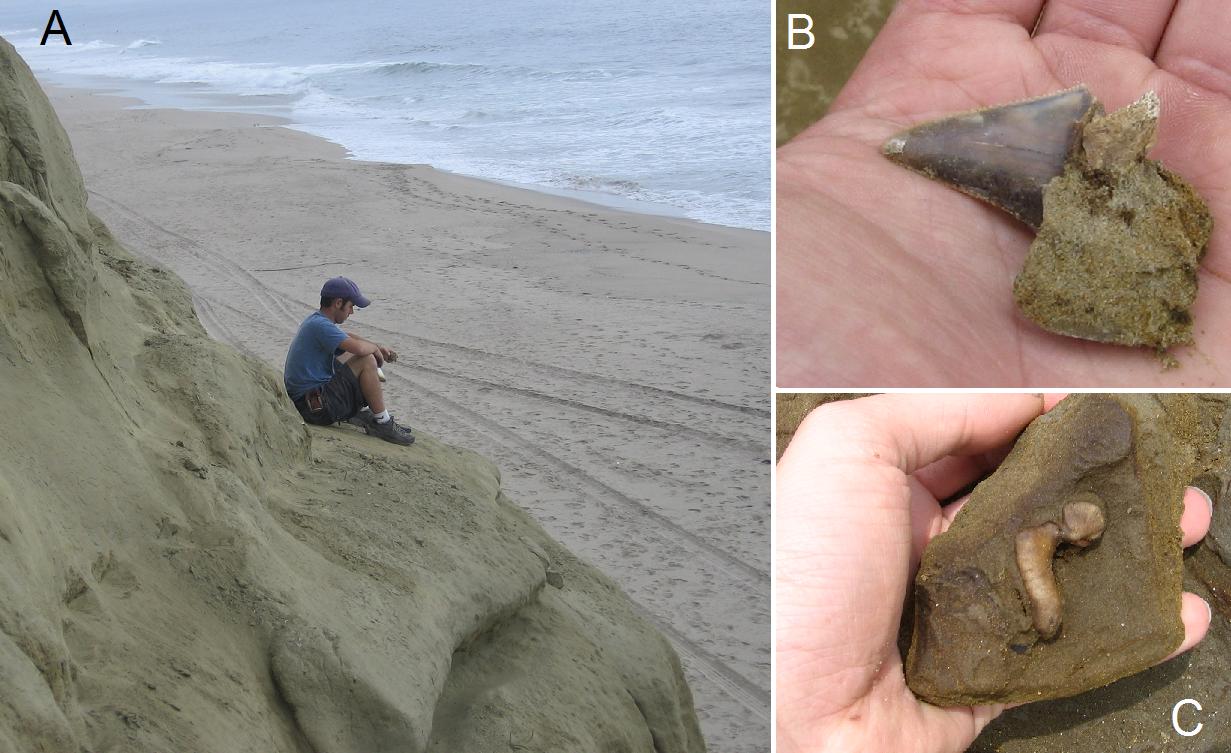
This week, we welcome guest blogger Robert Boessenecker. Bobby has been interested in paleontology since he was a kid. He grew up in the Bay Area; when he found Miocene shark teeth in the Santa Cruz Mountains, he was hooked. He first got involved with the UCMP when he was a high school freshman — he visited the museum with his dad, to interview UCMP Assistant Director Mark Goodwin for a school project. Bobby is now getting a Masters’ degree at Montana State University. He studies the taphonomy and preservation of marine vertebrate fossils in the Mio-Pliocene Purisima Formation of Central California.
After the completion of my first year of college, I was relaxing during my family’s annual vacation at Lake Tahoe. While at the beach I received a phone call from my uncle; a surfing buddy of his had discovered a bunch of fossil bones somewhere near Half Moon Bay. I was excited, primarily because few discoveries of fossil vertebrates had been made along the San Mateo County coastline. I knew that much of the county’s shoreline was made of the Purisima Formation, a rock unit I was familiar with from collecting fossils in the Santa Cruz area.
The Purisima Formation is late Miocene and Pliocene in age (7-2.5 Mya). In the Santa Cruz area, fossils of sharks, rays, skates, bony fish, sea birds, walruses, fur seals, dolphins, belugas, baleen whales, and sea cows had been discovered. With such a diverse fossil assemblage, I knew there was serious potential for discovery at this new spot in Half Moon Bay.
A day or two after we returned from Tahoe, my friend Tim Palladino and I followed directions to the locality, and sure enough, it was all Purisima Formation. When we arrived, the exact spot the surfer pointed out was up along a two foot wide ledge overhanging a thirty foot drop to the beach; neither of us were crazy enough to try climbing up there, and we decided to explore elsewhere. Shortly thereafter, we discovered several bonebeds with abundant bones and invertebrate shells preserved. Because the locality was on government-owned land, collecting without a permit was illegal.
After returning to Montana for my second year of college, I applied for (and eventually received) a permit, so that I could return to the locality and establish a collection. In summer 2005, I returned, and discovered a fossil skull of a baleen whale. The excavation took four days and half a dozen volunteers, but eventually the skull was excavated and wrapped in a plaster jacket for safe transport back to Montana. After the plaster jacket was removed that fall, I found that the skull was also encased in a concretion — the sandstone closer to the middle of the skull had been cemented with calcium carbonate, the same mineral in limestone. Needless to say, preparation took four and a half years, and was only finished in March 2010.
In 2006 I returned to the locality. We made two major finds that summer: the nearly complete skull of a fossil porpoise, and a complete lower jaw of the “‘dwarf”‘ baleen whale Herpetocetus. In addition to these finds, by the end of 2006 I had collected several shark teeth (including those of great white sharks, basking sharks, angel sharks, a mako shark, and even a sawshark), fish bones, the humerus of an extinct flightless auk (Mancalla diegensis), bones and teeth of a walrus and a fur seal, and multiple ear bones of porpoises and several baleen whales (Herpetocetus, a right whale, and a rorqual whale). All of this fossil material is currently under curation for UCMP collections. UCMP has more fossil material from the Purisima Formation than any other repository, and now it is the recipient of an entirely new fossil assemblage from the Purisima. All in all, the collection includes several hundred specimens that represent 22 different species of marine vertebrates.
To learn more about Bobby’s research, check out his blog, The Coastal Paleontologist.
[flickr album=72157624094552026 num=5 size=Square]